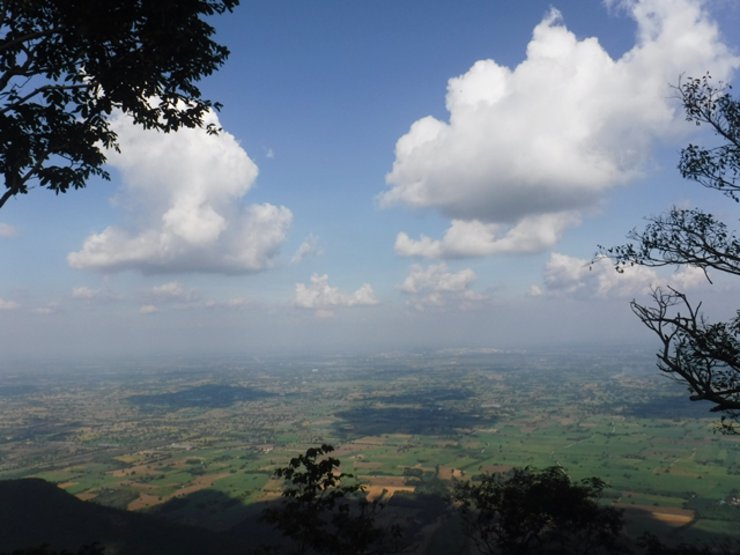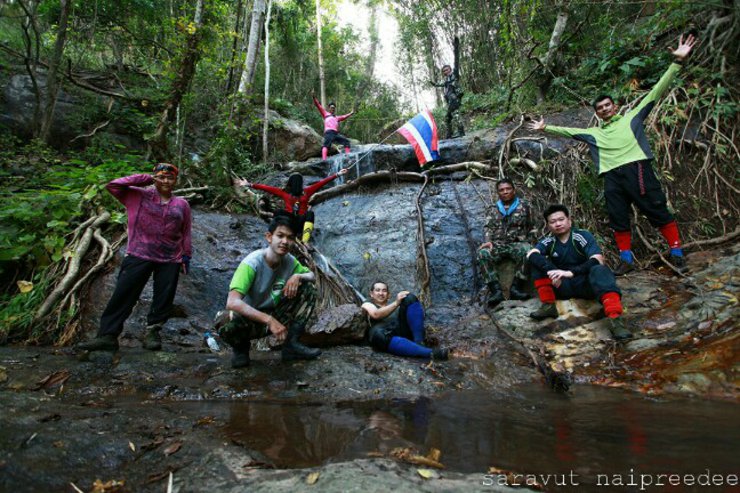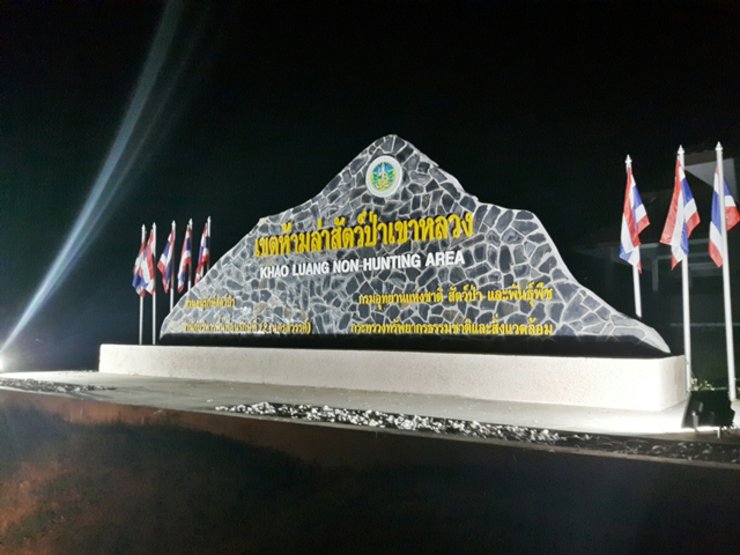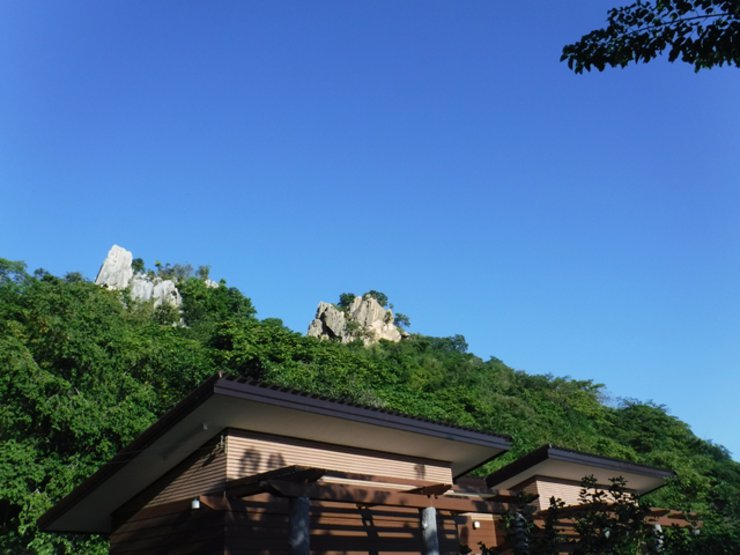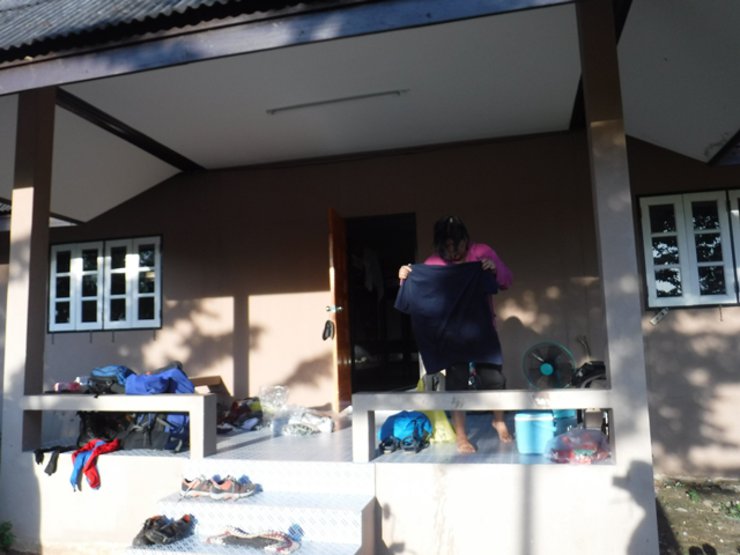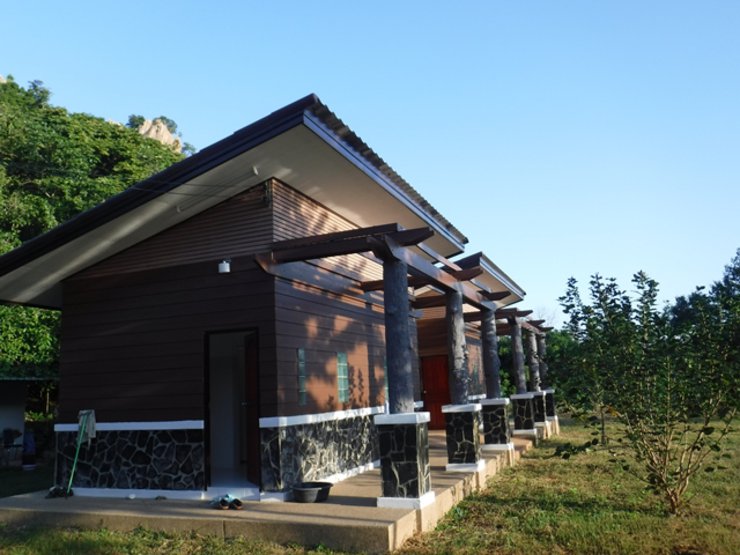





This trip was like the previous one, scrolling through Facebook and saw a post from my boss, Ton, who was looking for volunteers to help build a viewpoint at Khao Luang National Park in Nakhon Sawan and then continue to explore the summit of Khao Khieo. If there was time, as the path to Khao Khieo is a dense forest and difficult to walk through. I also helped post to find volunteers to help build the viewpoint, but no one came along. So this time, there were only 3 officials, Che, P'Wut, Goong, and 3 of Goong's friends. This trip, we had to carry our own backpacks, cook our own food, and manage our own supplies, as usual. Follow our journey to explore and build the viewpoint.

We traveled by bus from Kanchanaburi. The fare was 200 baht. We arrived at Nong Ben intersection and got off the bus. We waited for someone to pick us up in front of the Seven Eleven. A friend came to pick us up. (We arrived at Nong Ben intersection at 10 pm.)
Khao Luang National Park is located in Khao Luang National Forest Reserve, Plot 1 in Nakhon Sawan Province and Plot 2 in Uthai Thani Province. It covers a total area of 71,562 rai or 114.5 square kilometers. The Royal Forest Department established the park on February 22, 1996.
Key Features:
Khao Luang, the highest peak of the Luang mountain range, features a plateau suitable for camping with a constant cool breeze. Its scenic viewpoint offers panoramic views of the towns of Lat Yao in Nakhon Sawan province and Sawang Arom in Uthai Thani province. Additionally, the mountain boasts a large gold mine and approximately 20 smaller ones, discovered by locals following a treasure map over 50 years ago. Several natural springs, known as "Sa Kaeo," are believed to possess healing properties. Reaching the summit requires a 3-4 hour hike.
Khao Khiao is the second highest peak after Khao Luang, standing at 762 meters above sea level. Located south of Khao Luang, it is connected by a ridge trail spanning approximately 4-5 kilometers. The summit features the "Gold Digging Pit," connected to the "Seepage Spring" and the "Water Cave," a small cavern with year-round water seepage on its walls.
Tham Bua Ya is a large limestone cave located in the north. It serves as a meditation retreat for the monks of Wat Tham Bua Ya.
Khao Phra Cave is a small cave located at the northernmost end of the Khao Luang mountain range. The interior of the cave is relatively intact and is situated behind the Luang Pho Choy Pariwasakarm Monastery.
Khao Pratun Cave is a small limestone cave located above Tham Bua Ya Cave. It is in good condition.
Amenities
Khao Luang Forest Park does not offer accommodation or camping facilities for tourists. If tourists wish to stay overnight for leisure or to study nature, they must bring their own tents. The park provides a designated area with restrooms. Food must be prepared in advance. Tourists must contact the Khao Luang Forest Park officials directly to request permission to use the facilities. For more information, please contact the Nakhon Sawan Forest Management Office, Nakhon Sawan Province, Tel. (056) 221140.

The six members, Che, Phi Wut, Khun Kung, Phi Tem, Phi O, and Phi Sam, woke up early and prepared to pack their belongings.
Route: Wat Nam Luem - Wat Khao Luang - Pa Bu - Khao Khieo Peak - Krok Sala Waterfall - Krok Sa Waterfall


The bathroom is clean. Please take off your shoes before entering.


Surrounding area


Luggage is loaded onto the vehicle, passengers find their seats, and preparations are made for departure.


We left the park and headed to the starting point of our hike. The path was a gravel road that wound through fields, orchards, and a reservoir. It was quite a distance before we reached our destination.

We will start walking up from the house we forgot.


Stopped for lunch and bought supplies. Bought more and more and more.


The starting point of the procession at the Ban Luem Monastery.
Unload the goods from the car.

The additional items purchased include 1 kilogram of eggplant, a large package of fermented fish sausage, fermented pork sausage for grilling, shrimp paste, limes, and okra. The question is, who carried them? Whoever bought them carried them, accepting their fate with a resigned sigh.


Our guides, Headman Ton, Phi Tun, and Laem.
A photo before departure


The journey begins at 10:30 AM. The initial section is a flat, non-steep path through a bamboo forest.
The deciduous dipterocarp forest, also known as "pà téng rang" in Thai, is found at the foot of the hills before transitioning into the mixed deciduous forest. This forest is characterized by the presence of over 10 species of bamboo, out of the 50 species found in Thailand.
During the rainy season, Khao Luang has waterfalls cascading down the rocks at Wang Ma in La-Yai district and Khao Luang waterfall in Bang Pramung sub-district, Krok Phra district.


Gradually begins to rise.
The plant community in Khao Luang Forest Park can be divided into three types:
Found on the lower slopes of hills, the dry dipterocarp forest is characterized by a predominance of small-sized vegetation. Common tree species include dipterocarps (Shorea spp. and Dipterocarpus spp.), Lagerstroemia calyculata, Xylia xylocarpa, Pterocarpus macrocarpus, Afzelia xylocarpa, and various bamboo and cycad species.
The deciduous mixed forest, also known as the "Benjaphan Forest," is characterized by a sparse canopy and a diverse range of small to medium-sized trees. Bamboo thrives in this ecosystem, forming dense thickets. Notable tree species include olives, figs, teak, Siamese rosewood, red padauk, Siamese senna, wax apple, sweet leaf, moonflower, Siamese rough bush, cat's claw, and various bamboo species such as Schizostachyum lumampao, Bambusa tulda, Dendrocalamus strictus, and Bambusa vulgaris.
Dry evergreen forests are found only on the summit of Khao Luang. They are characterized by shrubs, vines, rattans, and orchids. Notable plant species include golden teak, white rubber tree, wild marian plum, duck's foot, sampong, ironwood, and rock ebony.
The park is home to a diverse range of wildlife, including both small and large mammals, such as bears, goral, barking deer, muntjac, monkeys, wild boars, porcupines, monitor lizards, pangolins, civets, squirrels, palm civets, wild rabbits, bats, mice, moles, bamboo rats, junglefowl, kalij pheasants, grey-headed parakeets, great slaty woodpeckers, barn owls, and various species of snakes.


The trail is teeming with mosquitoes, so be sure to bring insect repellent. Additionally, watch out for stray dogs, as they are prevalent in the area.


Fully prepared


Listen to the leader talk about the temple and the gold mine.


The path of ease is gone, farewell.


Carrying so much luggage for just a two-day trip, it's like they're moving to Mars. What on earth did they bring?


There are many large, gaping holes.


Taking a break from the advertisement. Oops, I meant taking a break from the work. The boss cut up a large papaya for us to eat. Toon was the one who carried it up.


The path is easy to get lost, even with signs, people still get lost.
Image below
The mucuna pruriens, also known as the cowhage, is a vine with long, bean-like pods covered in dense, golden-brown or reddish hairs. These hairs detach easily, becoming airborne and causing irritation due to their high serotonin content. Contact with the hairs can lead to severe itching and allergic reactions. The pods mature during the winter and dry seasons.
Mucuna pruriens seeds contain L-Dopa, a substance with significant influence on the reproductive system. It also acts as a neurotransmitter, contributing to the treatment of Parkinson's disease. However, L-Dopa must be extracted and processed into tablets before consumption, as the body cannot absorb the substance in its raw or processed seed form.
Traditional medicine practitioners have used **Mucuna pruriens** extensively, utilizing its roots, leaves, pods, and seeds. Notably, the seeds are considered the most potent part of the plant, boasting properties that enhance vitality and sexual performance.


Stumbled upon some delicious wild mushrooms. Mouthwatering! Almost threw out the fresh ingredients I brought (whoops! Saved them just in time).


Stop for coffee and grill mushrooms.


The trail was lined with peculiarly shaped termite mounds. The sound of termites was deafening, resembling the rattle of a rattlesnake.


Accept the slope, let it go.


On the way, we encountered a gecko snake. There's no need to go closer to take a picture. You can stand here and take it.
As we approached the summit of Khao Luang, the surrounding forest transitioned into a dry evergreen forest. This diverse ecosystem boasts an abundance of shrubs, vines, and large trees. However, the true treasure of this forest lies in its wealth of rare medicinal herbs, such as the prolific "Gling Klang Dong" plant.


Upon reaching the summit, one encounters an old hermitage, formerly the abode of Luang Pho Choi Janthasuwano of Wat Si Uthumphon (Wat Wang Due), Nong Krat Subdistrict, Mueang District, Nakhon Sawan Province. Luang Pho Choi once practiced asceticism and meditation on the mountaintop.
Venerable Luang Pho Choey Jantasuwanno of Wat Sri Uthumphon was a highly respected monk among the people of Nakhon Sawan.
Born April 8, 1913.
Died April 16, 2007
94 years old
Ordained on May 7, 1933.
He is the saint of Khao Luang Nakhon Sawan. In the past, he practiced asceticism on the top of Khao Luang to practice meditation.
A significant project undertaken by Luang Pho Choy was the construction of a reservoir, with the Chaipattana Foundation participating in the project. Notably, Her Royal Highness Princess Maha Chakri Sirindhorn graced the project with her presence, joining Luang Pho Choy in the construction of the reservoir.


On the peak of Khao Luang, there is a large gold mine pit. Nearby, there is a crystal-clear spring called "Sa Kaeo" by the locals.
On the summit of Khao Luang Nakhon Sawan, there is a gold-digging pit, believed to be a gold mining site since the late Ayutthaya period. Geologically, the peak of Khao Luang Nakhon Sawan is a gold-bearing vein. Currently, only abandoned pits remain, and gold mining is no longer practiced. This pit is large and deep, but it is now heavily silted due to the accumulation of soil and leaves.




After choosing our accommodation for the night, we helped our companions prepare the wild mushrooms. As there was no water source nearby, we used rainwater that had been collected.


After finishing the mushroom picking, Toon will stay at the accommodation while the rest of the group goes to the viewpoint. No one has had lunch yet.


Crawling and squeezing through the thorny brambles, I wonder what I'm doing here. Hahahaha!
Can anyone tell me what kind of bamboo has very long internodes? I saw it in the forest before, and now I found it here again.


Rolling in the middle of the forest, or rough-skinned old man, or wrinkled scrotum.
Properties
This medication is used to treat internal bruising and swelling, as well as pain in the knees, waist, and legs.
In ancient times, it was used as an ingredient in amulets and talismans for invulnerability and protection.


The trail was dense with towering trees, tangled vines, and abundant wild boar tracks. As we ventured deeper, a flock of chickens startled us with their sudden flight.


Found foreign objects


Upon reaching the scenic viewpoint, the work unit immediately began their tasks. Meanwhile, I stood by, cheering them on, only to be stung by a wasp. What a disappointment!


Exercise caution, as there is a deep chasm ahead.




Construct a barrier.








Grilled pork with salt by Laem
Deep-fried fermented fish sausage

While we were happily weaving fermented fish, we caught a glimpse of an orange glow. We quickly gathered to capture the sunset at the viewpoint. It was just us, Ms. Kung, and Headman Ton.



They almost missed it, having to half-walk, half-run to make it on time.


The menu consisted of two or three dishes prepared by each person. Che made fried fish sausage and chili paste with shrimp paste.

The morning atmosphere


Waking up early, the cooking team cooks, prepares meals, and plans the trek to Khao Khieo, all in one go.


Laem Hung Khao, Phi Tem makes Rad Na, Fried Rice, and Stir-fried Macaroni.


Laem prepares the northern Thai chili dip, while Che takes photos.


Have breakfast


Group photo taken, ready to set off.


The journey began around 10:00 AM.


Crawling and squeezing, the rope shortened, shortening until my knees ached.

Check the direction, find a way to cut up the ridge, but the path must go down to the valley which is a dense forest.


Go check the route.


The narrow path was like a tunnel, barely wide enough for a person to pass through. Each meter was a struggle, leaving me breathless.



There is no path to follow, only thorns and vines.


To avoid getting lost, it is necessary to constantly check your direction.


The group trekked through dense bamboo forests, pushing through the undergrowth until they were exhausted. They attempted to eat their lunch, but fatigue rendered them unable to finish.

There are many strangely shaped trees.


The image above depicts Imperata cylindrica, commonly known as cogongrass.
Other names: Good vine, Good echo, Good nod, Good goat, Good creep, Foot vegetable, Tokto (North); Yay Chi (South).
Botanical characteristics: A type of fern that creeps and twines around other trees, reaching several meters in length.
The stem is a short rhizome with dense, dark brown hairs, 3-6 mm in diameter. There are no scales. The mature stem is black and shiny.
The bipinnate frond has a creeping rachis. The rachis of the first-order pinna is distinct. The base of the petiole is brown, the upper part is yellowish-brown, and has brown hairs. The wings are not prominent or absent. The leaflets are arranged alternately on the rachis of the frond. The sterile leaflets have petiolules 2-4 mm long. The leaflet blade is lanceolate, 4-7 cm long, and 1-2 cm wide. The base of the leaf is cordate, the apex is rounded or acute, and the margin is serrate. The leaf surface has translucent hairs. The leaf blade is thin and papery, the upper surface is glabrous, and the lower surface has scattered hairs along the veins. The fertile leaflets are located above the middle of the rachis. The annulus consists of a single row of cells arranged transversely and located at the apex of the sporangium. The indusium is saccate and has translucent hairs. The sori are borne on the margin of the leaflets, up to 1 cm long and 1.5 mm wide. Found in various forests throughout the country, including deciduous forests, evergreen forests, mixed deciduous forests, and mixed deciduous forests. Young leaves and shoots are used in cooking, such as curries, stir-fries, or soups. The stems are used to make ropes, woven bags, and baskets.

The forest is pristine, with an abundance of mosquitoes. I have never encountered such a large number of mosquitoes while hiking.




After passing through the dense forest, everyone was overjoyed. They could finally breathe freely and felt a sense of relief. They decided to rest at that spot and leave their belongings behind. The steep climb to the top of Khao Khieo required agility and speed, and carrying their belongings would only slow them down.


The path is steep from the start.


They looked at each other.

Let's stop for a quick photo.



The viewpoint on Khao Khieo currently offers a limited perspective. Expanding it to a 360-degree panorama would significantly enhance its appeal, potentially creating a breathtaking nighttime experience with a celestial display of stars seemingly encircling viewers.

At its highest point, Khao Khieo reaches 755 meters. Image by Danet Bamrungtanakit.


After taking photos, we prepared to return as it was late afternoon. The leader said we would take a shortcut to get home faster. We were happy that the path was getting closer.
The path was unexpectedly steep, with a near-vertical drop that threatened to send us tumbling headfirst down the rocky slope. The relentless descent, coupled with the scarcity of water and the gnawing hunger, made for a grueling journey.


The sound of the waterfall made me thirsty.

Image of Danet Bamrungtanakit
The javelin thrower's hasty approach resulted in a nosedive landing.

Drink some water, what are you waiting for?


Bathe, apply powder, and take a group photo.

The trail continues along the waterfall stream.


Approaching the weir, a sense of relief washes over me, knowing that my destination is near.

It turned out beautifully.

We waited for the car to pick us up and return to the unit. Upon arrival, we showered. The "Khun Kung" group requested to leave immediately due to their long journey ahead. We stayed and had lunch with the head officer and a few others. We ate instant noodles, while the officer's wife prepared a delicious papaya salad with long beans and a spicy fermented fish salad.
This trip, I would like to express my sincere gratitude to everyone who joined me on this journey. It has been a truly memorable experience. The forest has given us life.
We will miss the important people when we have to part ways.
We will cherish the beautiful days as time passes.
I will miss the time we had together when you have to leave.
And now, do you know how much I miss you?
I'm Che
Friday, October 4, 2024 3:11 PM



